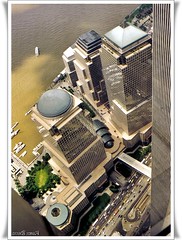Walking on Air Between the Towers
By A. O. SCOTT
Published: July 25, 2008
On the morning of Aug. 7, 1974, after months of preparation and years of dreaming, a French daredevil named Philippe Petit stepped into the sky above Lower Manhattan. For almost 45 minutes he ambled back and forth on a metal cable strung between the towers of the World Trade Center, a feat of illegal tightrope walking that, according to a New York Police Department sergeant who recounted Mr. Petit’s act of physical poetry in dry press-conference prose, would more aptly be described as dancing.
For many years after, Mr. Petit’s stunt was a cherished footnote in the annals of New York history, one of the touchstones of a crazy, awful, glittering era in the life of the city. The destruction of the twin towers in the terrorist attacks of Sept. 11, 2001, revived the memory of that earlier aesthetic assault on the buildings, which is now the subject of “Man on Wire,” James Marsh’s thorough, understated and altogether enthralling documentary. Wisely, Mr. Marsh, who based his film on a book Mr. Petit published in 2002, never alludes to Sept. 11. That would have been both distracting and redundant, since it’s impossible, while watching a movie so intimate in its attention to the towers, not to be haunted by thoughts of their fate.
But it is also worth recalling that the trade center inspired more love posthumously than while it stood. Mr. Petit was an exception. A zealous, daring wire walker — the French word funambule is a more lyrical, as well as a somewhat more ridiculous-sounding term — he conceived a passion for the structures even before they were built.
As he recalls it (and as Mr. Marsh imagines the scene in one of many witty, unobtrusive re-enactments), the young Mr. Petit was flipping through a magazine at a doctor’s office when he saw an article about plans to construct the two tallest skyscrapers in the world side by side at the bottom of Manhattan. In his mind, and then in a series of sketches and diagrams, he drew a simple line connecting the buildings and imagined himself perched atop it.
What kind of person would think of such a thing? How would he go about accomplishing it? Why? Those are the questions that preoccupy Mr. Marsh, whose earlier films include the semidocumentary “Wisconsin Death Trip” and the fictional feature “The King.”
The first question is answered largely by Mr. Petit’s own testimony. In his 50s, he is elfin and energetic, a beguiling combination of showboat, idealist and con man. And in his early, outlaw years, before the twin towers walk brought him fame and a measure of legitimacy, he combined an exalted sense of artistic mission with a street criminal’s sense of serious mischief.
Accordingly, “Man on Wire” is constructed like a heist movie, in the manner of “Rififi” or the revived “Ocean’s Eleven” franchise. Though Mr. Petit was alone on the cable that August morning, his walk in the sky was the result of a conspiracy of true believers and casual adventurers. In his two previous acts of guerrilla funambulism — at the Cathedral of Notre-Dame in Paris and on the Harbor Bridge in Sydney — he relied on the logistical and moral support of several friends, including his lover, Annie Allix, and his faithful sidekick, Jean-Louis Blondeau.
In interviews, they and some of Mr. Petit’s other confederates — including two American goofballs and Barry Greenhouse, a flamboyant insurance executive who served as the all-important inside man — reconstruct their project, which they referred to at the time as “the coup,” in fascinating detail. There were engineering problems and also challenges that seem to belong to the world of espionage, as well as the inevitable tensions that arise when a group of people pursue a dangerous goal.
Why did they do it? Rather than risking banality by addressing this question head-on, Mr. Marsh allows the answer to be at once self-evident and profoundly mysterious. A work of art is its own explanation, and “Man on Wire” leaves no doubt that Mr. Petit’s coup deserves to be called art. Mr. Blondeau, a sensitive and cerebral foil to the impish Mr. Petit, chokes up when he recalls watching his friend step out over the abyss. “The important thing is that we did it,” he says.
And without making any grandiose claims, this lovely, touching film demonstrates that the World Trade Center sky walk was an important event. The proof is in the emotions — amusement, amazement, awe — evoked by those images of a tiny human figure balancing above a void. Also gratitude. It is easy to imagine that, in contemplating the scale and solidity of those brand-new towers, Mr. Petit saw them at least partly as the vehicle of his own immortality (whether or not he survived the crossing). No one looking up at the New York sky on a hazy morning 34 years ago and seeing a man on a wire could have suspected that the reverse would turn out to be true.
“Man on Wire” is rated PG-13 (Parents strongly cautioned). It includes nudity, sexuality and drug references.
Subscribe to:
Post Comments (Atom)





No comments:
Post a Comment